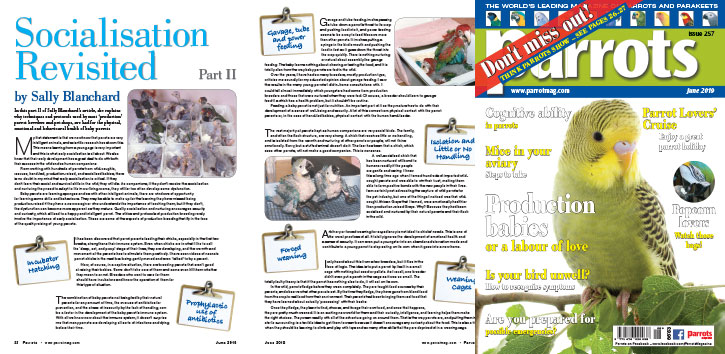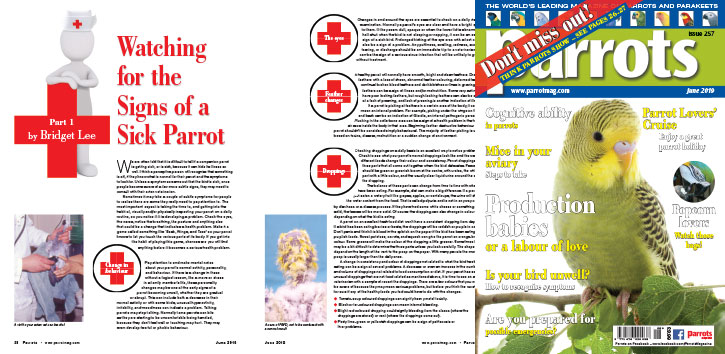
by Sally Blanchard
In this part II of Sally Blanchard’s article, she explains why techniques and protocols used by most ‘production’ parrot breeders and pet shops, are bad for the physical, emotional and behavioural health of baby parrots.
My first statement is that we now know that parrots are very intelligent animals, and scientific research has shown this. This means learning from a young age is very important and this is what early socialisation is all about. We also know that their early development has a great deal to do with both their success in the wild and as human companions.
From working with hundreds of parrots from wild-caughts, rescues, hand-fed, production-raised, and socialised babies, there is no doubt in my mind that early socialisation is critical. If they don’t learn their social and survival skills in the wild, they will die. As companions, if they don’t receive the socialisation and nurturing they need to adapt to life in our living rooms, they will far too often develop some dysfunction.
Baby parrots are learning sponges and as with other intelligent animals, there are windows of opportunity for learning some skills and behaviours. They may be able to make up for the learning they have missed being production-raised if they have a new caregiver who understands the importance of teaching them, but if they don’t, the dysfunction can become more apparent as they mature. Quality socialisation and nurturing encourages security and curiosity, which all lead to a happy and intelligent parrot. The ethics and protocols of production breeding rarely involve the importance of early socialisation. These are some of the aspects of production breeding that fly in the face of the quality raising of young parrots.me.
Buy Now!

Complete Psittacine by Eb Cravens
I went out after sunset to take in the food bowls from our aviaries recently, and discovered a couple of mice in Howdy and Zinnia’s cage picking through the leftover hulls and sprouts and such. It didn’t really freak me out since this happens periodically with most owners who have a cluster of outdoor flight cages. Besides, field mice on a farm are really rather tidy creatures. Still it was a problem to be dealt with as soon as possible because where you have two mice, as long as you keep feeding them you’ll get more.
From all the breeding facilities I have looked after in the past decades, it seems like an unwritten law that if you keep and maintain birds you are going to entice rodents to move into your locality. Not only do these little critters love dry seeds, extruded pellets, ripe fruit and nuts, they have an attraction to being around avian species of the smaller and helpless sort. Controlling rodents is a continual job for persons with large indoor, or outdoor, aviary complexes. Moreover, in our case here at The Perfect Parrot, we are doubly at risk, since we also own a 20-tree macadamia nut orchard on the parrot property.
Now, there are many ways of controlling individuals in the genera Rattus and Mus. And for those aviculturists who might find it helpful, these are our methods which evolved over the past 30 years:
Buy Now!

by Olivia Begasse de Dhaem, MD
Birds never stop to impress the readers of Parrots magazine. As a bird owner, it is fascinating to bond so deeply with a species that separated from humans about 320 million years ago. To put this in perspective, the most recent common ancestor between dogs and humans lived 100 million years ago. New archeological evidence suggests that the appearance of our current birds resembles dinosaurs.
Despite their remote divergence from humans and prehistoric appearance, parrots have been shown to have remarkable cognitive abilities. Dr Irene Pepperberg showed that her African Grey, Alex, could count to eight, add, subtract, and understood the concept of zero. Alex used our referential language for communication and even created words such as ‘yummy bread’ for cake. Alex could categorise objects according to their function, colour, shape, size, number of occurrences, and texture. He could assess the different characteristics of a given object simultaneously such as ‘this is square green wood’. Alex named more than 100 objects.
This article presents the current understanding of the biological basis behind parrots’ intelligence. The genetic, anatomical, organisational, functional, and evolutionary basis of parrots’ intelligence will be reviewed.
Buy Now!

Part 1 by Bridget Lee
We are often told that it is difficult to tell if a companion parrot is getting sick, or is sick, because it can hide its illness so well. I think a perceptive person will recognise that something is off, if they know what is normal for their parrot and the symptoms to look for. Unless a symptom screams out that the bird is sick, once people become aware of a few more subtle signs, they may need to consult with their avian veterinarian.
Sometimes it may take a couple of subtle symptoms for people to realise there are some they really need to pay attention to. The most important aspect is taking the time to, and getting into the habit of, visually and/or physically inspecting your parrot on a daily routine, so you notice if it is developing a problem. Check the eyes, the nares, notice the breathing, the posture and anything else that could be a change that indicates a health problem. Make it a game called something like ‘Beak, Wings, and Toes’ so your parrot knows to let you touch the various parts of its body. If you get into the habit of playing this game, chances are you will find anything before it becomes a serious health problem.
Buy Now!




